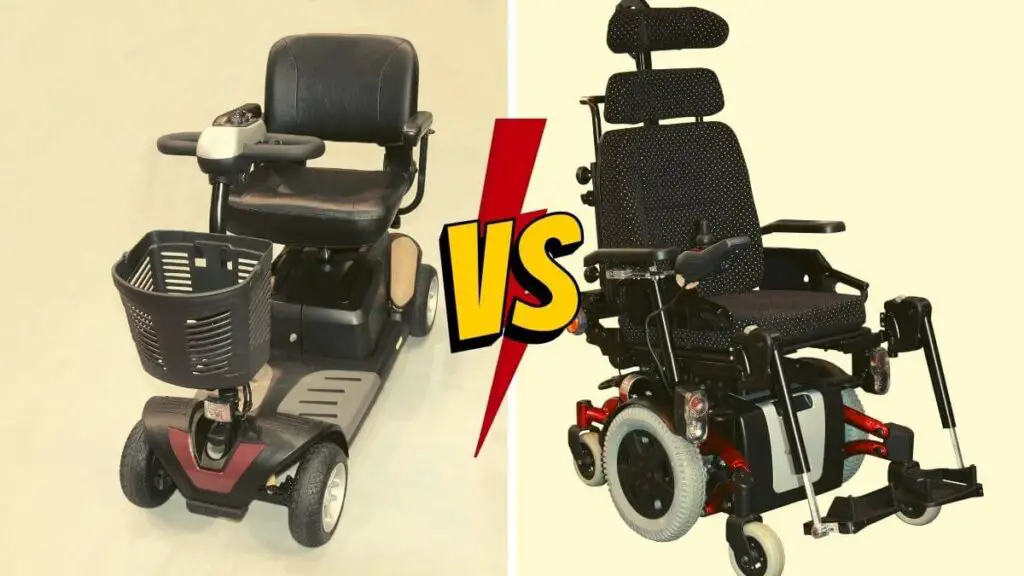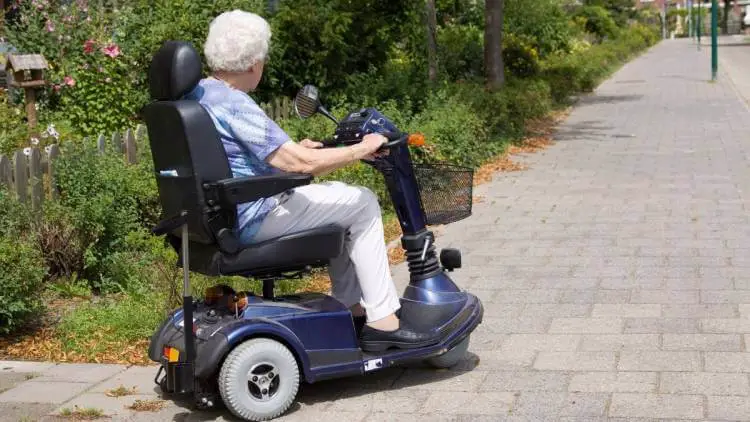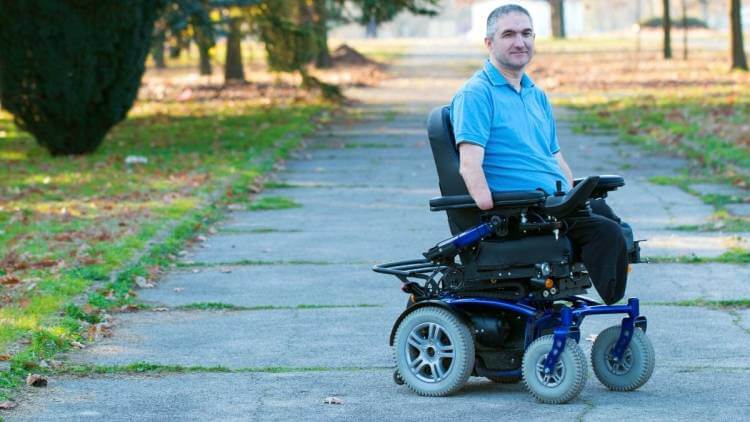When it comes needing a motorized mobility aid, seniors might wonder whether they need, a mobility scooter or electric wheelchair, and what the difference between them is. Both have their unique benefits and drawbacks, so it can be challenging to decide the best option for you. In this article, we will compare and contrast these two mobility aids and help you decide which one is right for you!
So, which is better, a mobility scooter or an electric wheelchair? This question is not a clear answer simply because someone with specific mobility issues could benefit more from a wheelchair than an electric scooter or vice versa. The question is what mobility device fits your particular needs the best.
Generally, an electric wheelchair is needed by people with more severe physical impairments than those who can benefit from a mobility scooter.
What is an Electric Wheelchair?
An electric wheelchair is a mobility device designed for people who have difficulty walking or propelling a manual wheelchair. They typically have four wheels, and the user sits in a chair-like seat. Batteries power electric wheelchairs, and they can be operated using a joystick or other control mechanism if needed.
People that need electric wheelchair to be covered by insurance will need to demonstrate medical necessity through a doctor’s order. Medicare lists power wheelchairs that need prior authorization before coverage. Mobility Medical Supply has published numerous reviews on various electric wheelchairs if you need comparison guides.
What is a Mobility Scooter?
A mobility scooter, also called a power scooter, is a mobility device designed to give people with mobility impairments the ability to move around independently. Mobility scooters typically have three or four wheels, and batteries power them. You will often find mobility scooters available for free use in grocery stores and large department stores.
The user sits on a seat, and they operate the power scooter using a handlebar with a thumb control that gets pushed to or squeezed to set the scooter in motion.
Medicare will cover mobility scooters for those that need them, but again, a doctor must authorize the scooter as being medically necessary.
7 Differences Between Mobility Scooters and Electric Wheelchairs
Despite their similarities, there are significant differences between the two motorized mobility aids.
1 – How They Are Operated
One of the main differences between is how the user operates them. A power wheelchair uses a joystick to move forward, backward, and turn. These joysticks are typically mounted at the end of the armrest of choice. Power scooters use a tiller and handlebar that users squeeze with their thumb to move, similar to how one would drive an all terrain vehicle.
2 – Maneuverability
When it comes to maneuverability and navigating tight spaces, power wheelchairs have the advantage. Some power wheelchairs can turn as tight as 20 inches, ideal for tight spaces. Mobility scooters have a turning radius of 32-45 inches. However, if you need to travel off-road, mobility scooters also come in off-road models.
3 – Portability
Another difference is mobility scooters can be disassembled for transport in a vehicle, and most can even be lifted once they are disassembled. But still, this can be difficult for one person to handle. A power chair typically does not offer this convenience as they are too large and bulky in most cases, requiring a purpose-built van, bus, or carrying device mounted to the back of a vehicle.
With that said, lighter, more portable electric wheelchairs have been built, allowing anyone to take the lightweight wheelchair almost anywhere you go because they can fold. Some even gold into one piece and can be as light as 35 pounds.
4 – Range
Mobility scooters typically have a more extended range than electric wheelchairs when it comes to range. For example, most mobility scooters can travel up to 20 miles on a single charge, while electric wheelchairs typically have a range of only about 12 miles.
5 – Weight Capacity
The make and model of both types of mobility aids will determine the weight capacity. In general, you can find power wheelchairs with a weight capacity of up to 350 pounds. However, bariatric power wheelchairs that are heavy-duty can support weights from 400 to 700 pounds.
Mobility scooters have similar weight capacities, and heavy-duty models can hold up to 600 pounds or more. On average, mobility scooters can hold weights from 250 – 350 pounds. Because of this, each device is comparable in the weight capacity range.
6 – Wheels
Mobility Scooters
The power scooter typically has three or four wheels for stability, and the wheels are typical all the same size. 3-wheel models are lighter and have a higher turning radius than their 4-wheel counterparts. 4-wheel is more stable and can go over different terrain types.
Power Wheelchairs
Power chairs have four wheels, and typically, the back two wheels or the rear wheel are larger than the front. This is for stability reasons as well.
Some models of power chairs will have six wheels adding even more stability. The front casters can also be adjusted to different settings depending on the terrain type you’ll be using it on most frequently.
Mid-wheel drive mobility chairs have the wheels placed under the center of the chair as opposed to the back or front. This gives the mid-wheel drive chair more stability and a shorter turning radius. These types of power chairs are also easier to maneuver over obstacles.
Front-wheel drive mobility chairs have wheels placed in the front of the chair. This gives the chair the ability to turn tight but can be less stable on specific terrain types. In addition, the power is transferred to the front wheels, thus a front-wheel-drive chair.
Rear-wheel drive mobility chairs have wheels placed in the back of the chair, which provides stability on different terrain types but needs a larger area to turn.
7 – Cost
The average cost of a power wheelchair is between $1,500 and $4,000, while the average cost of a power scooter is between $4,000 and $7,000, depending on the model and features chosen.
The cost is worth it when you factor in all the features and benefits that each mobility aid offers, particularly if Medicare or Medicaid is picking up most of the cost.
Both mobility scooters and electric wheelchairs offer many features and benefits that make life easier for those with mobility issues. Both can be equipped with wheelchair accessories to make transportation and daily life easier.
It is essential to do your research to find the right mobility aid for you. Consider your needs, budget, and lifestyle when making your decision.
Who Should Use a Mobility Scooter?
Mobility scooters are best suited for individuals who need assistance with mobility issues but do not have difficulty walking short distances.
If you only need help to get around your home or neighborhood, a mobility scooter is a great option. They are also easy to operate, so they are a good choice for those not comfortable using a power wheelchair.
Pros:
- It can be disassembled into smaller, lighter pieces for easy transport
- Great for outdoor use over different terrain
- Easier to operate than an electric wheelchair
- Lower cost than a power wheelchair
Cons:
- It cannot be used indoors as easy
- Users with hand problems will have issues using the tiller bars
- It cannot turn as tight as a power wheelchair
Who Should Use an Electric Wheelchair?
Power wheelchairs are a good option for individuals who cannot walk, have difficulty walking long distances, or who have little to no upper body strength.
They are also a good choice for those who need to use their mobility aid on uneven or inclined surfaces. Finally, if you have the budget for it, a power wheelchair is an excellent option for those who need a mobility aid on a more permanent basis.
Pros:
- Tighter turns are ideal for indoor use
- It can be used on any terrain
- More comfortable than a mobility scooter
Cons:
- More expensive than mobility scooters
- Bulky and difficult to transport in a vehicle unless an ultralight is purchased
- Harder to use than a mobility scooter for first-time users
Mobility Scooter or Electric Wheelchair – Which is Best for You?
The mobility device should be based on your needs, lifestyle, and mobility issues. For example, a mobility scooter is an excellent option if you need help getting around your neighborhood or running errands.
If you have difficulty walking long distances or suffer from arthritis, a power wheelchair may be a better mobility aid.
Consider your budget when choosing a mobility device as well. For example, power wheelchairs tend to be more expensive than mobility scooters, but they offer more features and a tighter turning radius.
Think about where you will be using your mobility aid when deciding. For example, if you need help getting around your home, a power wheelchair is excellent.
If you plan on using your mobile device outdoors, a mobility scooter or electric scooter, as some call it, is the better option as they are easier to operate and can be used on any terrain.
No matter what mobile device you choose, make sure it meets your needs and budget.
Final Thoughts
There are many factors to consider when choosing between a mobility scooter and an electric wheelchair. Cost, mobility needs, terrain, and indoor/outdoor use are essential factors. Ultimately, the mobility device should be based on your needs and lifestyle. If you have any questions about which mobility aid is right for you, please consult with your doctor to further clarify your mobility needs.





4 comments
PLEASE get a hold of an occupational therapist if you have a hard time deciding between motorized wheelchair or scooter. I am an OTA and I have seen so many times, that families buy one or the other for their loved one and they are unable to use it. There are a number of reasons for this, but I hate it when families waste their money on something so expensive and are unable to use it.
is it common for elderly folk to find using a joystick difficult to use
It’s possible, yes.
We had a tough time deciding if a mobility scooter or electric wheelchair was better for my grandma. This post was exceptionally helpful. We went with an electric scooter from Scooters Buy. Thank you!